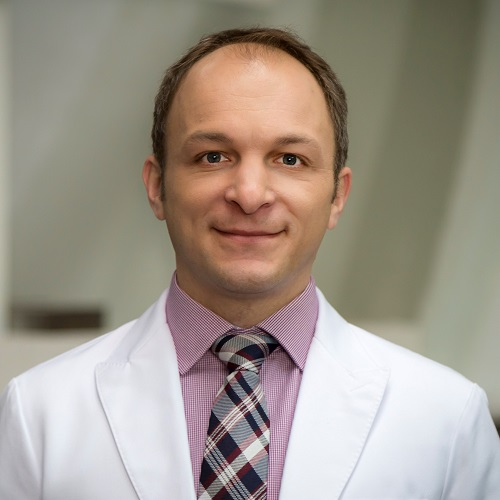 Corneliu Sima, DMD, MSc, DSc, is an assistant professor of oral medicine, infection, and immunity at Harvard School of Dental Medicine (HSDM). As a clinician-scientist, Sima brings his interest in bridging the gap between bench and chairside activities to working closely with the Initiative to Integrate Oral Health and Medicine, conducting research on how to use artificial intelligence and machine learning to offer better, safer care to patients with periodontal disease.
Corneliu Sima, DMD, MSc, DSc, is an assistant professor of oral medicine, infection, and immunity at Harvard School of Dental Medicine (HSDM). As a clinician-scientist, Sima brings his interest in bridging the gap between bench and chairside activities to working closely with the Initiative to Integrate Oral Health and Medicine, conducting research on how to use artificial intelligence and machine learning to offer better, safer care to patients with periodontal disease.
Tell us a little bit about your background.
I grew up in Brașov, a city in the Transylvania region of Romania. I went to college nearby at Dr. Ioan Mesota National College, where I majored in mathematics and physics. I then underwent a six-year DMD program with an extensive medical education component and graduated as valedictorian at University of Medicine and Pharmacy Cluj, also in Romania.
After that, I earned my DSc in Oral Biology at Boston University, and then I completed my MSc in Periodontology and my residency at the University of Toronto. I was a post-doctoral fellow at the University of Toronto, then came back to the Boston area on a National Institutes of Health grant to the Forsyth Institute, where I spent three years developing my independent research career. I joined the HSDM faculty in 2018, where I run a lab that looks at oral-systemic links, in particular between periodontitis and cardiometabolic diseases like diabetes.
How long have you been collaborating with the Initiative to Integrate Oral Health and Medicine? Discuss your role.
I have been working with the Initiative since I began working at Harvard; I was introduced to it by then-department chair Roland Baron who knew that my interest in the oral-systemic connection would be a great fit.
What are some of your current projects that are related to the Initiative and/or CIPCOH?
I am currently the PI on an Initiative-funded study to use artificial intelligence and machine learning applications to better understand who needs to be seen in-office for periodontic screenings. In this project, we’re working to utilize multiple data modes—such as electronic health records and clinical notes, periodontal charting, medication history, intraoral photos, and x-rays—into an algorithm that can predict who needs in-office clinical exams for periodontitis and who doesn’t. We’re trying to determine the minimum number of data modes required to screen with high sensitivity and specificity.
Some of this technology is already being used by orthodontists, who can monitor using a patient’s own intraoral photos from their smartphone. Our goal is to integrate this algorithm into a smartphone app that will also allow patients to communicate easily with their oral health provider. We have 200 cases that are fully coded on all data modes, and we’re using half of them for training the algorithm and the other half for testing.
What attracted you to work that prioritizes the integration of oral health and primary care?
I have been interested in this area essentially since I started dental school, where I was fortunate to be exposed to a deep medical education as well. During my six years at UMF Cluj, I had classes and hospital rotations in all disciplines, from gynecology to psychiatry to endocrinology. I do believe that dental medicine is essentially a medical specialty, and we ought to do our best to integrate them together for a holistic approach.
Having experienced both the European and North American educational systems in dental medicine, I think the Harvard Dental Medicine educational system shows a stronger link between oral health and primary care education compared to other North American schools, in part because at Harvard the education in dental care and medicine were integrated from the beginning.
How has the COVID-19 pandemic highlighted the importance of an interprofessional approach to oral health, primary care, and overall health?
This kind of telemedicine approach in my AI/ML research is especially important in the midst of a global health pandemic, when maintaining social distancing is critical for lowering the spread of disease and access to care is reduced compared to pre-pandemic times.
To get an even more holistic look at exactly how the COVID-19 pandemic is affecting oral health services, we are currently conducting a study to determine the impact of the pandemic on periodontal services and access for patients in academic and non-academic settings in the U.S. We utilized the BigMouth Dental Data Repository, as well as a large representative data set from the private sector. This work is ongoing and pending publication, and I look forward to sharing results soon.

In your opinion, what does the future of integrated primary care and oral health look like?
Hopefully, we can move into the direction of health systems that provide both oral and systemic health care, similar to some like Kaiser-Permanente that are already developing in the U.S. One of the critical missing links we have in the current system is a lack of shared electronic health care records—it’s a much more efficient way to share information between providers on both sides, thus far better for monitoring and integrating care for patients.
Integrating medical and dental records would be beneficial to practice and understanding patient’s health. For example, it is often difficult in dentistry to know what medications patients are on, since medical history is mostly self-reported by patients and isn’t always accurate.
In addition to more traditional EHR systems, an interesting option is blockchain technology, in which a decentralized ledger of all patient records would make it possible for healthcare providers to access medical data safely and easily.
